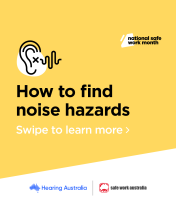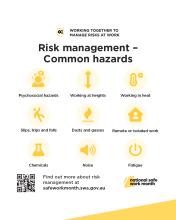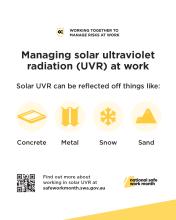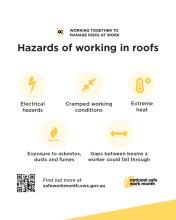Risk management
Risk management involves thinking about what could happen if someone is exposed to a hazard – things and situations that could harm a person – and how likely it is to happen. Using control measures to eliminate or if not possible, minimise risks in the workplace can prevent workplace injuries and illnesses, improve the health, wellbeing and capacity of workers, and improve the quality and productivity of work. Under Australia’s Work Health and Safety (WHS) laws, persons conducting a business or undertaking (PCBUs), such as employers, have a primary duty for managing work health and safety risks.
Without work-related injuries and illness, the Australian economy would be $28.6 billion larger each year. This shows that WHS is critical to our prosperity; workplaces that are safe and free of injury and illness provide benefits for all Australians.
A safe and healthy workplace does not happen by chance or guesswork, but through proactive, ongoing risk management.
Identifying and assessing risks
Identifying hazards means finding the things or situations that could cause harm – physical, psychological or both. It’s a requirement to consult workers and their health and safety representatives throughout the risk management process, including when identifying hazards in the workplace.
Once hazards have been identified, assess the risks they create. Undertake a risk assessment when there is uncertainty about how a hazard may result in harm or something changes, for example, when new equipment is introduced or the workplace layout is changed. For high risk construction work, a risk assessment is mandatory.
Controlling and reviewing risks
WHS risks must be eliminated if it is reasonably practicable to do so. If not, risks must be minimised so far as is reasonably practicable using control measures. 'Reasonably' means doing everything you are reasonably able to do to ensure health and safety.
When planning to implement control measures it’s important to consider what information, training, instruction or supervision is required for workers, to ensure the control measures are effective.
Reviewing the effectiveness of control measures is important to ensure they are working as planned. Don’t wait for something to go wrong! Remember, risk management is an ongoing, proactive process. Control measures should be reviewed regularly and must be reviewed if a new risk is identified, before any changes at the workplace, and if a review of the measure is requested.
Remember, workers and their health and safety representatives must be consulted when deciding how to control WHS risks and when reviewing control measures.
Risk management is central to building a safe and healthy workplace. This National Safe Work Month, take the time to talk about how WHS risks are managed in your workplace through a SafeTea event or toolbox talk, and remember to make WHS part of core business every month of the year.
Resources
Risk assessments
- Identify, assess and control hazards | Safe Work Australia
- Managing WHS risks - A step by step approach | Safe Work Australia
- Principles that apply to WHS duties – Principle 4: Management of risks factsheet| Safe Work Australia
- Model Code of Practice: How to manage work health and safety risks | Safe Work Australia
WHS risks in construction
- Know your duties in the construction industry
- Construction | Safe Work Australia
- Safe work method statement for high risk construction work - information sheet | Safe Work Australia
- Construction work - Work of minor nature - information sheet | Safe Work Australia
- Model Code of Practice: Construction work | Safe Work Australia
Noise
- Noise | Safe Work Australia
- Infographic – How to find noise hazards
- Infographic – Keep the noise down!
- Infographic - Hazardous noise in the workplace
- Infographic - Noise hazards and sound levels
- Model Code of Practice: Managing noise and preventing hearing loss at work | Safe Work Australia
Working in extremes
- Working in heat | Safe Work Australia
- Working outside | Safe Work Australia
- Working at heights | Safe Work Australia
- Managing the risks of solar ultraviolet radiation | Safe Work Australia
- Infographic - Working in heat | Safe Work Australia
- Managing risks of working in heat fact sheet | Safe Work Australia
- Safe use of ladders | Safe Work Australia – video link
- Working at heights | Safe Work Australia – video link
- Guide for managing the risks of working in heat | Safe Work Australia
- Guide on exposure to solar ultraviolet radiation | Safe Work Australia
- Model Code of Practice: Managing the work environment and facilities | Safe Work Australia
- Model Code of Practice: Managing the risk of falls at workplaces | Safe Work Australia
This October we will focus on a different health and safety area for each week of National Safe Work Month.
Stay updated
To keep updated about National Safe Work Month, follow us on social media and subscribe to our mailing list. When subscribing, be sure to check ‘National Safe Work Month’.
Subscribe | Facebook | LinkedIn | New! Instagram | YouTube | SoundCloud | #safeworkmonth






